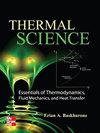Experimental and numerical investigation of Rayleigh-Bénard convection in rectangular cavity with motor oil
IF 1.1
4区 工程技术
Q4 THERMODYNAMICS
引用次数: 0
Abstract
Naturally flows have been the scope of the scientific research for centuries, Rayleigh-B?nard convection being one of the leading. Many researchers have considered the flow patterns, boundary conditions, various cavities, nanofluids, theoretically, numerically, experimentally. The flow was investigated in atmosphere and in nano fluids, in air, water, molten metals, non - Newtonian fluids. Almost all research focuses on 2 or 3 - dimensional analysis of flow in laterally unlimited enclosures, as parallel plates or coaxial cylinders. In technical practice, only limited enclosures exist. This paper presents numerical and real experimental results for the test chamber with ratio 4?2?1 in x, y and z direction, respectfully. The measurements were taken at fifteen different positions on the faces of the tank. Probes used are PT100 elements. As the chamber is limited in all directions, the results have shown strong influence of the lateral walls. The results are compared with the those obtained by IR camera. Various fluids were tested, and results for motor oil will be presented.加机油的矩形腔内瑞利-巴程纳德对流的实验与数值研究
几个世纪以来,自然流动一直是科学研究的范围。Nard对流是主要的对流之一。许多研究人员从理论上、数值上和实验上考虑了流型、边界条件、各种空腔、纳米流体。研究了大气、纳米流体、空气、水、熔融金属和非牛顿流体中的流动。几乎所有的研究都集中在二维或三维的流动分析,在横向无限的封闭,如平行板或同轴圆柱体。在技术实践中,只有有限的外壳存在。本文给出了比例为4 / 2 / 2的试验箱的数值和实际试验结果。x, y, z方向各1个。测量是在水箱表面的15个不同位置进行的。使用的探头是PT100元件。由于腔室在各个方向上都是有限的,结果表明侧壁的影响很大。并将所得结果与红外相机所得结果进行了比较。测试了各种流体,并将介绍机油的测试结果。
本文章由计算机程序翻译,如有差异,请以英文原文为准。
求助全文
约1分钟内获得全文
求助全文
来源期刊

Thermal Science
工程技术-热力学
CiteScore
2.70
自引率
29.40%
发文量
399
审稿时长
5 months
期刊介绍:
The main aims of Thermal Science
to publish papers giving results of the fundamental and applied research in different, but closely connected fields:
fluid mechanics (mainly turbulent flows), heat transfer, mass transfer, combustion and chemical processes
in single, and specifically in multi-phase and multi-component flows
in high-temperature chemically reacting flows
processes present in thermal engineering, energy generating or consuming equipment, process and chemical engineering equipment and devices, ecological engineering,
The important characteristic of the journal is the orientation to the fundamental results of the investigations of different physical and chemical processes, always jointly present in real conditions, and their mutual influence. To publish papers written by experts from different fields: mechanical engineering, chemical engineering, fluid dynamics, thermodynamics and related fields. To inform international scientific community about the recent, and most prominent fundamental results achieved in the South-East European region, and particularly in Serbia, and - vice versa - to inform the scientific community from South-East European Region about recent fundamental and applied scientific achievements in developed countries, serving as a basis for technology development. To achieve international standards of the published papers, by the engagement of experts from different countries in the International Advisory board.
 求助内容:
求助内容: 应助结果提醒方式:
应助结果提醒方式:


